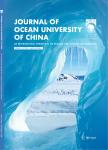Distribution and Characteristics of Hazardous Geological Features in the Marine Coastal and Offshore Areas of Zhejiang Province, East China Sea
Distribution and Characteristics of Hazardous Geological Features in the Marine Coastal and Offshore Areas of Zhejiang Province, East China Sea作者机构:Key Laboratory of Marine Environmental Geology Ministry of Natural Resources Qingdao Institute of Marine Geology Laboratory for Marine Geology Qingdao National Laboratory for Marine Science and Technology First Institute of OceanographyState Oceanic Administration Institute of Marine Geology and Geophysics Vietnam Academy of Science and Technology
出 版 物:《Journal of Ocean University of China》 (中国海洋大学学报(英文版))
年 卷 期:2018年第17卷第6期
页 面:1318-1324页
核心收录:
学科分类:07[理学]
基 金:supported by the China-ASEAN maritime cooperation fund (Comparative Study of Holocene Sedimentary Evolution of the Yangtze River Delta and the Red River Delta) the National Natural Science Foundation of China (Nos. 41306063 and 41330964) the China Geology Survey (Nos. GZH201200506 and DD20 160145)
主 题:hazardous marine geological features shallow gas coastal and offshore areas East China Sea
摘 要:Newly acquired high-resolution shallow seismic profiles(7069 km in length) in the coastal and offshore areas of Zhejiang Province, East China Sea, China, have revealed eight marine hazardous geological features: shallow gas, sand ridges, erosion ditches, scarps, irregular bedrock features, underwater shoals, buried paleo-channels, and submarine deltas. Based on the seismic profiles, we have constructed a marine geological map of these hazardous features. Shallow gas accumulations are common and occur mainly in two separate nearshore regions that cover 4613 and 3382 km^2 respectively. There are also scattered shallow gas accumulations in the offshore area, typically accompanied by paleo-channels that occur mainly in the middle of the study area. Sand ridges, erosion ditches, scarps, and irregular bedrock features are found mainly in the northeast of the study area in association with each other. In the southeastern part of the study area, the sand ridges have a linear form and trend NW–SE, representing the western part of the linear sand ridges in the East China Sea. The maximum slope gradient is 1?, which suggests that this area is prone to landslides. These hazardous marine geological features are important to marine and engineering activities in this region.



